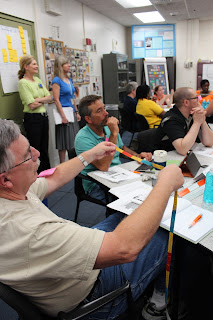 |
| Willie May giving an introduction of NIST |
The 2013 Summer Institute for Middle School Teachers began today with an introduction to NIST by Willie May. He gave an overview on how NIST touches so many different aspects of the economy and our lives. It was really interesting to hear about the examples of measurement and standards in science, technology, medicine and commerce. Mary followed this up with some basic information about the institute.
 |
| Mary Introducing the Summer Institute |
We finished the morning off with two tours, one by Jennifer Huergo about NIST in Your Community and the other by Keith Martin of the NIST Museum. Jennifer shared about how NIST has done research on the World Trade Center, food standards, information technology, and in many other areas. Keith provided a lot of really great information on the history of metrology and showed interesting examples of NIST products, like neon signs and space beads.












This was a great summary of our day! I think it was amazing to see how much sugar was in each beverage and seeing the sugar in the plastic bags really made it visual. I think this would work wonders with my 6th grade students and hopefully hit home for them. I know many love to drink soda but do not think there are affects to them. This would be a great activity to also include writing where they can compare and contrast the beverage and amount of sugar and why one is better than another.
ReplyDelete-Rachel Keller
I liked the new approach to getting my kids a more engaging activity on using the SI system. AWESOME first day, looking forward to the next9 :)
ReplyDeleteThe first day was awesome, I learned so much about measurements and how to introduce the information to my students. I love making it fun so they gave me some more tools for my toolbox. I loved going to the apple tree. I loved the museum and the history of the beginning of measurements. I am also having a great time today with the true measurement of Pi
ReplyDeleteI meant to ask during Monday's discussion, "what do you do with the gasoline once you have completed the test"?
ReplyDelete